THIS WEEK at HILTON POND
8-14 March 2004
(Back to Preceding Week; on to Next Week)
11-19 Nov 2017 & 20-28-Jan 2018 Come be part of a real |
|
HERE COME THE RUBY-THROATS (Updated 27 Mar 2017) After a long winter without Ruby-throated Hummingbirds, it's gratifying to know this diminutive Neotropical migrant is reportedly making its way back toward Hilton Pond Center and points north. It's hard to explain to folks who aren't hummingbird enthusiasts just how crucial this news is to those of us who brew batches of sugar water all summer long, but the annual arrival of spring migrant ruby-throats is one of the most-anticipated happenings in the world of backyard birdwatchers. Ruby-throats have already appeared along the Gulf Coast and are moving their way northward, so it's only a matter of time until phones start ringing and E-mails start flying as folks announce "I just got my first one at the feeder!" Since hummingbird watching is a such a highly competitive sport, few things are more important than being able to say you spotted the neighborhood's first ruby-throat of the season.
Click HERE for larger map At this time of year, as days lengthen and temperatures begin to warm, the most common inquiry we hear is "When should I put out my hummingbird feeders?" We have two responses to this eternal question. If you did NOT have a winter hummingbird feeding program, we must respond to the query of when to put out the feeder in spring by simply saying it depends on where you live. As far as ornithologists know, northward migration by Ruby-throated Hummingbirds in spring is tied to photoperiod on the birds' wintering grounds. Hummers in Mexico or Costa Rica don't watch the Weather Channel, so they have no idea what the temperatures are like in the Carolinas or Montreal in mid-March. Like other migrant birds, hummers are always "cheating" a little and trying to extend the limits by arriving earlier than their competitors, but those that cheat TOO much may end up freezing or starving to death during a particularly cold spring. Conversely, some late-arriving ruby-throats actually may get the last laugh on early birds if a sudden April snowstorm decimates hummers that arrived first. In nature, organisms are always caught between this kind of "rock and a hard place." It's such constant tension between hummingbirds and environmental factors that makes natural selection so dynamic a phenomenon--and one that's always fun to study. But back to the question of when to put out your hummingbird feeder. Native Americans reportedly observed the sudden appearance of Ruby-throated Hummingbirds each spring long before Europeans settled North America, and they also saw the relationship between these long-billed little birds and tubular flowers upon which they naturally feed. If you check the map at the top of this page, you'll see the line labeled "April 1" passes along the border between the Carolinas. Hilton Pond Center sits just south of that border near York SC, so we would rightly conclude that our first Ruby-throated Hummingbird should appear on about April Fool's Day. Amazingly, our earliest-ever unbanded ruby-throats arrived on 27 March in FOUR different years (1991, 2011, 2014 & 2017)--which is pretty darned close to 1 April--and over the past 34 years, 14 of our first arrivals at Hilton Pond Center have come on 30 March-6 April. The bottom line from all this is that we advise folks in the Carolina Piedmont within a hundred miles or so of York to have their feeders up not later than St. Patrick's Day, 17 March. It's worth noting that the lines on our map don't take into account local conditions such as altitude. In fact, almost no work has been done on whether Ruby-throated Hummingbirds arrive at different times on mountaintops than in adjoining valleys, or in natural areas vs. the suburbs. Likewise, we don't know much about the impact of microclimate on hummingbird migration, or how microclimate and altitude and other abiotic factors may affect breeding success or double brooding. Those are the kinds of questions being looked at by students, teachers, and other adults in the U.S., and Canada who are involved in Operation RubyThroat through The GLOBE Program, and is why we went to Black Hawk County, Iowa a few weeks ago to train folks in our hummingbird protocols. Operation RubyThroat/GLOBE participants in Canada and the Midwest are looking at other aspects of hummer behavior, including whether Ruby-throated Hummingbirds are extending their breeding range past the pink line on the map at the top of the page. (Note also that migrant ruby-throats may be seen outside the breeding range.) They're also collecting data on when the last fall ruby-throats are seen across North America so we can construct a map that shows departure dates in fall migration. If you reside in the Carolina Piedmont, it's high time to hang your hummingbird feeder, but if you live much north of Hilton Pond Center you have a little time left. In any case, have your binoculars ready and try to determine the sex of that first Ruby-throated Hummingbird that arrives--an easy call in spring when only males (below) have the bright red throat that gives this long-awaited migrant species its name.
All text, maps & photos © Hilton Pond Center
NOTE: Be sure to scroll down for an account of all birds banded or recaptured during the week, as well as some other interesting nature notes. "This Week at Hilton Pond" is written and photographed by Bill Hilton Jr., executive director of Hilton Pond Center for Piedmont Natural History. You may wish to consult our Index of all nature topics covered since February 2000. You can also use the on-line Search Engine at the bottom of this page. For a free, non-fattening, on-line subscription to "This Week at Hilton Pond," just send us an E-mail with Subscribe in the subject line. Please be sure to configure your spam filter to accept E-mails from hiltonpond.org. |
|
Make direct donations on-line through
Network for Good: |
 |
|
LIKE TO SHOP ON-LINE?
Donate a portion of your purchase price from 500 top on-line stores via iGive: |
|
|
Use your PayPal account to make direct donations:
|
|
|
|
|
|
|
SPECIES BANDED THIS WEEK: * = New species for 2004 WEEKLY BANDING TOTAL YEARLY BANDING TOTAL BANDING GRAND TOTAL VAGRANT HUMMINGBIRDS All text & photos © Hilton Pond Center |
OTHER SIGHTINGS OF INTEREST NOTABLE RECAPTURES THIS WEEK American Goldfinch (1) Eastern Towhee (1) Northern Cardinal (3) White-throated Sparrow (2) |
(Back to Preceding Week; on to Next Week)
|
Up to Top of Page Back to This Week at Hilton Pond Center Current Weather Conditions at Hilton Pond Center |
 post questions for The Piedmont Naturalist |
Join the |
Search Engine for |
|
|
Blu-Ray Disc Player

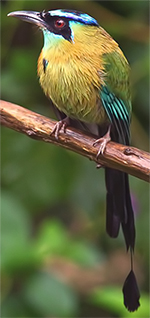 JUST ANNOUNCED!
JUST ANNOUNCED! 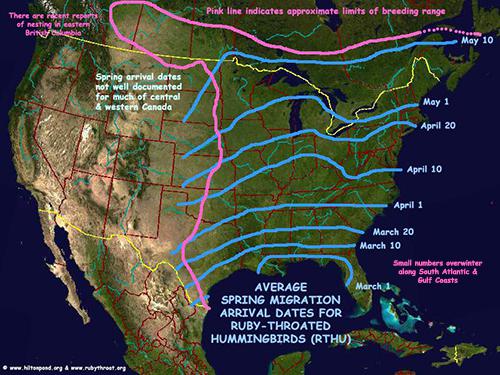
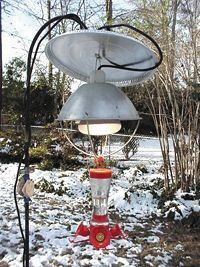 First, if you are a true hummingbird enthusiast in the eastern U.S., you maintained one feeder all winter long--just in case one of those vagrant hummers wandered in (see
First, if you are a true hummingbird enthusiast in the eastern U.S., you maintained one feeder all winter long--just in case one of those vagrant hummers wandered in (see 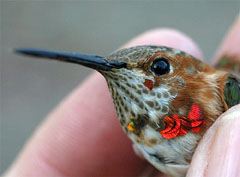 Obviously, since migrant Ruby-throated Hummingbirds showed up in the southern parts of Texas and Florida as early as late February--a few even overwintered in coastal states--it is already well past the date to have your feeder up if you live in Miami or Corpus Christi. For Canada and most of the rest of the U.S., however, you still have time.
Obviously, since migrant Ruby-throated Hummingbirds showed up in the southern parts of Texas and Florida as early as late February--a few even overwintered in coastal states--it is already well past the date to have your feeder up if you live in Miami or Corpus Christi. For Canada and most of the rest of the U.S., however, you still have time.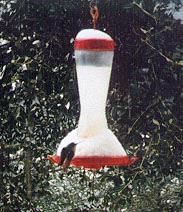 Instead, when day-length reaches a certain level, an individual hummingbird's hormones kick in and bring about an urge to migrate. Hummers whose internal clocks run a little too fast migrate a little too soon, and they may arrive to find North America cloaked in snow (left) and devoid of nectar flowers and nutritious little insects. If they're slow to depart the tropics, they get to their breeding grounds to find earlier birds are already defending prime habitats, and latecomers during any given year may have to settle for not mating at all or, at best, raising weak offspring on insufficient resources.
Instead, when day-length reaches a certain level, an individual hummingbird's hormones kick in and bring about an urge to migrate. Hummers whose internal clocks run a little too fast migrate a little too soon, and they may arrive to find North America cloaked in snow (left) and devoid of nectar flowers and nutritious little insects. If they're slow to depart the tropics, they get to their breeding grounds to find earlier birds are already defending prime habitats, and latecomers during any given year may have to settle for not mating at all or, at best, raising weak offspring on insufficient resources.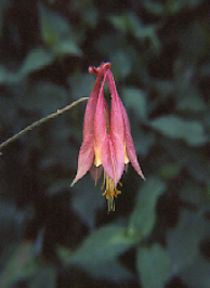 In the past 50 years or so, folks have become quite active in offering artificial nectar as food, and in making observations about arrival dates of migrant ruby-throats. As a result, various groups and individuals--including our
In the past 50 years or so, folks have become quite active in offering artificial nectar as food, and in making observations about arrival dates of migrant ruby-throats. As a result, various groups and individuals--including our  That may be a "wee bit" early, but putting out a feeder on the traditional Irish holiday makes it easier NOT to forget when to do it--and even if there are no hummingbirds in Ireland. For the rest of the country and Canada, we simply recommend that you hang a feeder--perhaps only one-fourth full--two weeks before the day indicated by the line on the arrival map.
That may be a "wee bit" early, but putting out a feeder on the traditional Irish holiday makes it easier NOT to forget when to do it--and even if there are no hummingbirds in Ireland. For the rest of the country and Canada, we simply recommend that you hang a feeder--perhaps only one-fourth full--two weeks before the day indicated by the line on the arrival map.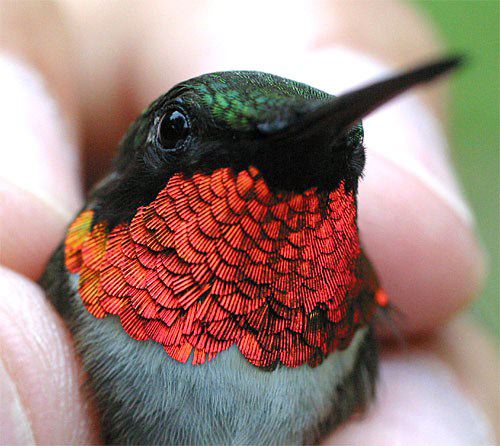
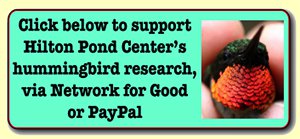

 Oct 15 to Mar 15
Oct 15 to Mar 15 Please report your
Please report your